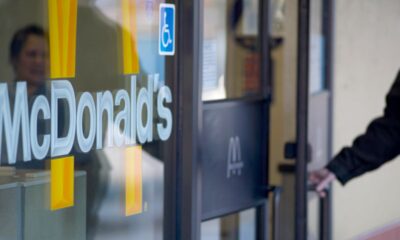Connecticut
Pandemic put tax burden on CT’s poorest, report shows

Connecticut’s already regressive tax system swung even more sharply onto the backs of its poorest residents during the coronavirus pandemic’s first year, according to a new fairness study from Gov. Ned Lamont’s administration.
The lowest-earning 10% effectively spent almost 40% of their income in 2020 to cover state or municipal tax burdens, more than five times the rate faced by Connecticut’s highest earners – and two-and-a-half times the statewide average, according to the tax incidence analysis released Thursday by the Department of Revenue Services.
The 39.9% state and municipal tax rate effectively paid by the poorest 10% also is up dramatically from the nearly 26% rate assigned to that same group by a 2022 DRS tax fairness study, which analyzed data from 2019.
Meanwhile, taxpayers in the two middle groups paid 13% and 11.5%, respectively, of their income to cover tax burdens in 2020, up from 9.2% and 8.6% in 2019.
“This latest study just confirms what people in Connecticut have been feeling in their wallets for the last several years — a dangerous combination of historic inflation, an upside-down tax system and an extreme disinvestment in critical public services and infrastructure,” said Norma Martinez-HoSang, director of Connecticut For All, a coalition of more than 80 labor, faith and civic organizations that has advocated for higher tax rates on wealthy households and corporations to finance relief for low- and middle-income families.
The study breaks Connecticut’s earners into deciles, or groups that earned 10% of all statewide income.
For example, it took the poorest 883,552 tax filers to earn about $19.3 billion, which was 10% of all statewide earnings in 2020. This the group that paid almost 40% of its income to state and municipal tax burdens.
Unlike in past reports, the administration did not include a projected income range for the households in this group. But dividing $19.3 billion by 883,552 filers yields a rough average income of slightly more than $21,843 per year.
The second decile includes the next-highest earners, another 316,630 filers, who also made $19.3 billion. Their effective tax rate was 19.8%, and their average income was $60,960.
MORE STORIES IN BUDGET/ECONOMY
CT lawmakers, Lamont add $17 million to winter heating assistance
CT legislators to consider adding $13.5M for winter heating assistance
The highest decile, the top 10%, involves 478 filers that earned $19.3 billion. This is the group that paid 7.3%, or less than one-fifth the rate of the poorest decile, and earned an average of $40.3 million.
Roughly two-thirds of all revenues generated by state and local government combined in 2020 came from property, sales and other taxes that largely are regressive in nature, the study found.
A regressive tax does not adjust rates based on a household or business’s earnings or wealth. A progressive levy, such as the state income tax, features multiple rates that collect more as the filer’s income increases.
A second problem with regressive taxes is that responsibility for the bill can more easily be shifted, something that’s particularly burdensome for poor households, the study found.
For example, renters effectively pay some or all their landlords’ property taxes. Gasoline distributors shift wholesale fuel tax burdens onto service stations, which pass the full cost on to motorists.
As a supplement, the report also covered a second methodology that relies upon only half of the tax burden shifts that the primary section of the report assumes. But even under this scaled back version, the lowest earning 10% of filers pay an effective rate of almost 33%, while the richest 10% pay 7.3% and the statewide average is 13.4%.
Lamont, a Greenwich businessman and fiscally moderate Democrat who says higher tax rates would prompt Connecticut’s wealthy to flee the state, said through a spokeswoman that his administration has been and continues to work to make the state’s overall tax system more progressive.
“Gov. Lamont is strongly committed to making our tax structure more progressive so that all Connecticut residents have an opportunity to succeed here,” spokeswoman Julia Bergman said. “That’s why, in recent years, the governor and the legislature have cut taxes for working families, boosted the Earned Income Tax Credit and expanded exemptions on certain pension and annuity earnings to benefit seniors.”
Bergman was referencing a series of tax changes enacted last year that represented the single-largest state income tax cut in Connecticut history, a package expected to save low- and middle-income families $200 to $400 each next fiscal year, more than $415 million in total.
Lamont and legislators also enacted a broad package of tax cuts in 2022 that included temporary relief, such as a 13-month gasoline tax holiday and an income tax rebate for households with children. But it also expanded a state income tax credit that offsets a portion of municipal property tax burdens and reduced the statewide property tax cap on motor vehicles from 45 mills to 32.46 mills. (One mill generates $1 of tax revenue for every $1,000 of assessed property value.)
Because tax fairness studies routinely lag several years of tax data, the recent relief Lamont approved is not included in the latest analysis.
“There’s definitely value in looking at this [study], but also I think the next set of studies will really tell the tale in terms of the progressivity that’s been implemented by this governor,” said Department of Revenue Services Commissioner Mark Boughton.
But critics counter that Connecticut’s tax system has overburdened the poor and middle class for decades, and recent relief won’t reverse an overall trend toward worsening inequity. They say economic damage caused by the pandemic continues even now, while the 40-year high in national inflation reached in mid-2022 also set Connecticut families back.
“We expect Gov. Lamont to respond with a reminder of recent tax cuts, which will have little impact on our state’s extreme economic inequities,” Martinez-HoSang said, adding that an income tax surcharge on the capital gains earnings of Connecticut’s wealthiest families could create significant economic change.
Connecticut Voices for Children, a progressive, New Haven-based policy think-tank, renewed its call Thursday for a new state income tax credit for low- and middle-income filers with children. It argues this credit could channel $300 million annually to assist about 80,000 kids.
Connecticut Voices’ executive director, Emily Byrne, said her group has just begun its review of the latest tax fairness report but said the overall problem the General Assembly faces is clear.
“The report not only reaffirms that our state’s tax system is regressive, but it also reaffirms why this report is so important,” she said, “because it allows the legislature to make informed decisions. … It’s also clear that more families need help.”
The Yankee Institute, a conservative fiscal policy group in Hartford, had just begun its review of the tax study late Friday. But spokesman Bryce Chinault said, “This report demonstrates why the recent income tax reforms were so important to Connecticut residents, and why the fiscal guardrails are vital to building upon that success.”
Those “guardrails” are a reference to caps on spending and borrowing and other savings programs that have helped reduce state debt by billions of dollars since 2020, which advocates say enables state government to channel more resources to cities and towns.
Members of the legislature’s tax-writing Finance, Revenue and Bonding Committee received the report Thursday morning, and leaders said the 77-page analysis would get close attention in the coming weeks.
But both Sen. John Fonfara, D-Hartford, who co-chairs the panel, and Rep. Holly Cheeseman of East Lyme, ranking House Republican on finance, said it’s clear Connecticut must find a way to ease property tax burdens.
The property tax generated nearly $12 billion in revenue in 2020, more than any other state or municipal tax did, and represented 38% of all tax revenue raised in Connecticut that year.
Fonfara pushed two years ago to boost rates on Connecticut’s richest families and on large corporations and set up a new fund to support economic development and other services in the state’s poorest cities. It was blocked by Lamont and other fiscal moderates and conservatives.
House Speaker Matt Ritter, D-Hartford, brokered a compromise that abandoned the tax hikes but authorized $175 million in annual bonding for urban investment that began in the 2022-23 fiscal year and runs through 2026-27.
The property tax “punishes those who have the least income,” Fonfara said Thursday, adding that the high mill rates in Connecticut’s urban centers make it very hard to attract commercial and industrial development. “It pits one town against another.”

Connecticut
Ecuadorian national with manslaughter conviction sentenced for illegally reentering United States through Connecticut

NEW HAVEN, CT. (WFSB) – An Ecuadorian national with a manslaughter conviction was sentenced to 12 months and one day in prison for illegally reentering the United States through Connecticut after being deported.
40-year-old Darwin Francisco Quituizaca-Duchitanga was sentenced and had used the aliases Darwin Duchitanga-Quituizaca and Juan Mendez-Gutierrez.
U.S. Border Patrol first encountered Quituizaca in December 2003, when he used the alias Juan Mendez-Gutierrez and claimed to be a Mexican citizen. He was issued a voluntary return to Mexico.
Connecticut State Police arrested him in March 2018 on charges related to a fatal crash on I-91 in North Haven in March 2017. He was using the alias Darwin Duchitanga-Quituizaca at the time.
ICE arrested him on an administrative warrant in Meriden in August 2018 while he was awaiting trial in his state case. An immigration judge ordered his removal to Ecuador in September 2018, but he was transferred to state custody to face pending charges.
Quituizaca was convicted of second-degree manslaughter in January 2019 and sentenced to 30 months in prison.
After his release, ICE arrested him again on an administrative warrant in Meriden in August 2023. He was removed to Ecuador the next month.
ICE arrested Quituizaca again on a warrant in Meriden on June 28th, 2025, after he illegally reentered the United States. He pleaded guilty to unlawful reentry on July 30th.
He has been detained since his arrest. U.S. Immigration and Customs Enforcement investigated the case.
The case is part of Operation Take Back America, a nationwide initiative by the Department of Justice to combat illegal immigration and transnational criminal organizations.
Copyright 2026 WFSB. All rights reserved.
Connecticut
Justice Department sues Connecticut and Arizona as part of effort to get voter data from the states
HARTFORD, Conn. (AP) — Officials in Connecticut and Arizona are defending their decision to refuse a request by the U.S. Justice Department for detailed voter information, after their states became the latest to face federal lawsuits over the issue.
“Pound sand,” Arizona Secretary of State Adrian Fontes posted on X, saying the release of the voter records would violate state and federal law.
The Justice Department’s Civil Rights Division announced this week it was suing Connecticut and Arizona for failing to comply with its requests, bringing to 23 the number of states the department has sued to obtain the data. It also has filed suit against the District of Columbia.
Attorney General Pam Bondi said the department will “continue filing lawsuits to protect American elections,” saying accurate voter rolls are the ”foundation of election integrity.”
Secretaries of state and state attorneys general who have pushed back against the effort say it violates federal privacy law, which protects the sharing of individual data with the government, and would run afoul of their own state laws that restrict what voter information can be released publicly. Some of the data the Justice Department is seeking includes names, dates of birth, residential addresses, driver’s license numbers and partial Social Security numbers.
Other requests included basic questions about the procedures states use to comply with federal voting laws, while some have been more state-specific. They have referenced perceived inconsistencies from a survey from the U.S. Election Assistance Commission.
Most of the lawsuits target states led by Democrats, who have said they have been unable to get a firm answer about why the Justice Department wants the information and how it plans to use it. Last fall, 10 Democratic secretaries of state sent a letter to the Justice Department and the Department of Homeland Security expressing concern after DHS said it had received voter data and would enter it into a federal program used to verify citizenship status.
Connecticut Attorney General William Tong, a Democrat, said his state had tried to “work cooperatively” with the Justice Department to understand the basis for its request for voters’ personal information.
“Rather than communicating productively with us, they rushed to sue,” Tong said Tuesday, after the lawsuit was filed.
Connecticut, he said, “takes its obligations under federal laws very seriously.” He pledged to “vigorously defend the state against this meritless and deeply disappointing lawsuit.”
Two Republican state senators in Connecticut said they welcomed the federal lawsuit. They said a recent absentee ballot scandal in the state’s largest city, Bridgeport, had made the state a “national punchline.”
Connecticut
New businesses heading to West Haven’s shoreline

New businesses are soon set to replace old, rundown buildings in West Haven.
By the end of the summer, the former Savin Rock conference center is slated to become the Kelsey, a restaurant and banquet facility.
Crews are currently working on the inside, according to Mayor Dorinda Borer.
Next door, Jimmies of Savin Rock sits empty after it closed last month. It was open for a hundred years and is now for sale.
Borer said it’s another opportunity to draw people to the city.
“When there are new developers in town, and they’re making things all bright and shiny, that makes people attracted to our city,” Borer said. “It just seems like everything’s starting to bust loose at once. It’s a lot of work behind the scenes, and then it all starts to come to fruition.”
Thirty new luxury apartments are set to replace the Debonair Beach Motel that fell into disrepair after its last day open more than a decade ago. Demolition began last fall, and it’s expected to continue in March.
Down the street, new condos were built by the same owner of the restaurant and bar Riva. They opened their doors last summer, welcoming eager crowds.
“The turnout’s been unbelievable,” Riva’s owner, Michael Delvecchio, said. “People traveling from other states, New York, Rhode Island, all over Connecticut. It’s something that West Haven been dying for.”
Riva replaced Chick’s Drive-In, a West Haven hot-dog and seafood staple that closed in 2015 after its owner passed away.
Delvecchio doesn’t ignore that history. A sign that says “The Lodge at Riva” will be removed and replaced with “Chick’s” during the summer, with accompanying pictures of Savin Rock amusement park on the walls.
“Everybody in town has been, with all this shoreline and all this beach, waiting for something to happen,” he said. “Riva’s a little bit of everything.”
-

 News1 week ago
News1 week agoFor those who help the poor, 2025 goes down as a year of chaos
-

 Detroit, MI4 days ago
Detroit, MI4 days ago2 hospitalized after shooting on Lodge Freeway in Detroit
-

 Dallas, TX3 days ago
Dallas, TX3 days agoDefensive coordinator candidates who could improve Cowboys’ brutal secondary in 2026
-

 Southeast1 week ago
Southeast1 week agoMurder in small-town America: The crimes that tore quiet communities apart in 2025
-

 Technology2 days ago
Technology2 days agoPower bank feature creep is out of control
-

 Midwest1 week ago
Midwest1 week agoMcDonald’s locks doors to keep out individuals who present ‘a risk’ in crime-ridden Minneapolis area
-

 West1 week ago
West1 week agoApex predator threatening Northwest salmon sparks rare bipartisan push to ‘kill more’
-

 Southwest1 week ago
Southwest1 week agoMissing 19-year-old Camila Mendoza Olmos believed to be ‘in imminent danger,’ Texas sheriff says





















